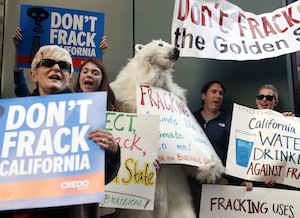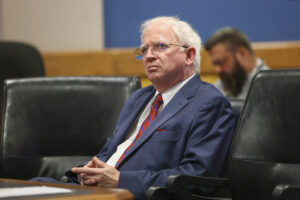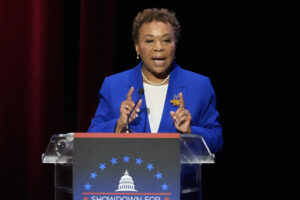Fracking and the New War on Air Pollution in Los Angeles
Over the past 50 years, the city of Los Angeles has made great strides to curb its smog problems by cutting vehicle emissions. But now, the emerging "fracking" industry threatens to undo much of that progress by wantonly spewing toxic chemicals into the air.By wantonly spewing toxic chemicals into the air, the emerging "fracking" industry threatens to undo much of the progress Los Angeles has made to curb smog pollution over the past 50 years.
Over the past 50 years, the city of Los Angeles has made great strides to curb its smog problems by cutting vehicle emissions. But now, the emerging “fracking” industry threatens to undo much of that progress by wantonly spewing toxic chemicals into the air.
Fossil fuel companies, in an attempt to squeeze more and more oil and gas out of the earth, have popularized a highly invasive and polluting method of extraction called hydraulic fracturing or “fracking,” which involves pumping a high pressure cocktail of water, sand and toxic chemicals into the ground to coax out remaining energy reserves.
While much of the public backlash against fracking has rightly focused on groundwater pollution in rural areas of the northeastern United States, California now appears to be a new epicenter of the fracking industry. The vast Monterey Shale formation of rocks that lies beneath Central and Southern California is thought to contain 15.4 billion barrels of untapped oil. The problem of course is that heavily populated areas cover much of this vast potential source of fossil fuel.
Kassie Siegel is the director of the Climate Law Institute at the Center for Biological Diversity. She explained to me that, “Los Angeles has the country’s largest urban oil field, and oil and gas development is spread throughout residential areas. These wells are being fracked and that brings new air pollution in addition to all the pollution that comes with conventional oil and gas drilling.”
Los Angeles residents have found that in addition to groundwater pollution, the very air they breathe is being contaminated by fracking operations. In fact, according to Siegel, “When the oil and gas industry moves into people’s neighborhoods, the immediate problem is from air pollution. About 40 percent of the chemicals known to be used in fracking go into the air.” She explained that the toxins become airborne “when the chemicals are being mixed or when the ‘fracking fluid’ comes back up to the surface if it’s being stored in an uncovered container or in a pit. Those chemicals go into the air where people breathe them. You can even absorb them through your skin.”
A dramatic example of such air pollution is an oil field run by Allenco Energy Co. in the University Park area of South Los Angeles — just half a mile from the University of Southern California campus — where fracking released so many toxic chemicals into the air that hundreds of nearby residents complained of health problems such as nosebleeds and nausea. Two federal regulators from the Environmental Protection Agency who examined the site themselves reported suffering from sore throats and headaches. The operation was temporarily halted at the urging of California Sen. Barbara Boxer.
Siegel warned, “There are hundreds of chemicals known to be used in fracking. About a quarter of them are known carcinogens. Many others make people nauseous, dizzy and even cause seizures.” She rattled off some of the most dangerous chemicals commonly used in Los Angeles operations: “Methanol, which harms the skin, eyes, lungs, liver and brain; hydrochloric acid; hydrofluoric acid; and 2-Butoxyethanol, which is known to cause adrenal tumors.” Most vulnerable to the effects of these chemicals are children living in urban residential areas of Los Angeles. “Children are absolutely one of the most vulnerable groups to this air pollution,” said Siegel, “and the American Lung Association has said that the evidence is irrefutable that these fracking chemicals cause problems.”
Responding to a growing movement against fracking across California, the state’s legislature passed a bill aimed at regulating the industry. But SB 4, which was signed into law by Gov. Jerry Brown this fall, was opposed by most environmental groups because it does little to curb fracking. Instead, it simply requires companies to begin reporting the chemicals they pump into the ground and does not even address air pollution. The law also launches studies of the impact of fracking on the environment and human health, but allows wells to operate while the studies are being conducted. Siegel conceded that the new law is “certainly better than the status quo, which was completely uncontrolled, unchecked fracking expanding throughout our state.”
“But,” she complained, “it’s not nearly enough to protect people and the environment.”
In fact, Brown, who is known for promoting progressive and climate-friendly energy policies, has faced severe scrutiny from environmentalists who are upset that SB 4 does not go far enough. Activists have confronted the governor publicly at numerous events across the state, chanting “climate leaders don’t frack.”
Until now, the fracking industry in California has incredibly been allowed to conceal the chemicals it was pumping into the air and water, claiming they are protected trade secrets. This should come as no surprise given that the precautionary principle by which most polluting industries around the world are regulated, is rarely applied in the U.S. In other words, instead of requiring companies to prove that their actions do not harm public health, polluters are allowed to operate freely until the victims of their contamination can prove harm.But, according to Siegel, “People have an absolute right to know what’s in the air they breathe.” So instead of relying on the state to protect residents, Siegel’s organization, the Center for Biological Diversity, has joined a coalition of local and statewide environmental groups in signing a letter calling on the South Coast Air Quality Management District to properly monitor air pollution from fracking projects within Greater Los Angeles. The SCAQMD was created in 1976 to address air pollution in Southern California at the height of the “war on smog” and is considered the best-poised government agency to monitor air pollution from fracking projects. Currently the SCAQMD requires companies to self-report air pollution, but the letter’s signatories want the agency itself to actually measure the levels of toxicity. Additionally, they want the agency to close the trade-secret loopholes used by the fracking industry to conceal the chemicals from the public.
While the immediate water and air pollution caused by fracking is of great concern, there is also the long-term carbon dioxide pollution that will result from burning the harvested fossil fuels, which will further exacerbate climate change. Ironically, President Obama has implicitly backed fracking in his plan to combat global warming by touting natural gas as a “transition fuel” from coal to renewable energy. Siegel made the case that, “these are unconventional fossil fuels that need to stay in the ground if we are to respond to the climate crisis and avoid really serious climate disruption. It makes absolutely no sense to allow this activity to expand in California just at the moment when we have to transition to a clean energy future.”
What Siegel and her fellow activists ultimately want is for California to follow in the footsteps of New York state by implementing a moratorium on fracking. Although several attempts to ban the practice have failed at the state level, there may be good news locally for L.A. residents, as two City Council members recently proposed a citywide halt to fracking. There is precedence: Many municipalities around the country have done the same, most recently cities in Colorado and Ohio.
Fracking has generated one of the largest oil and gas booms in the United States today. Although energy companies in California and around the nation are reaping generous profits, ordinary people are suffering. The question, which leaders such as President Obama and Governor Brown have yet to address, is whether the cost of fracking to current and future generations is really worth it.
Your support matters…Independent journalism is under threat and overshadowed by heavily funded mainstream media.
You can help level the playing field. Become a member.
Your tax-deductible contribution keeps us digging beneath the headlines to give you thought-provoking, investigative reporting and analysis that unearths what's really happening- without compromise.
Give today to support our courageous, independent journalists.






You need to be a supporter to comment.
There are currently no responses to this article.
Be the first to respond.